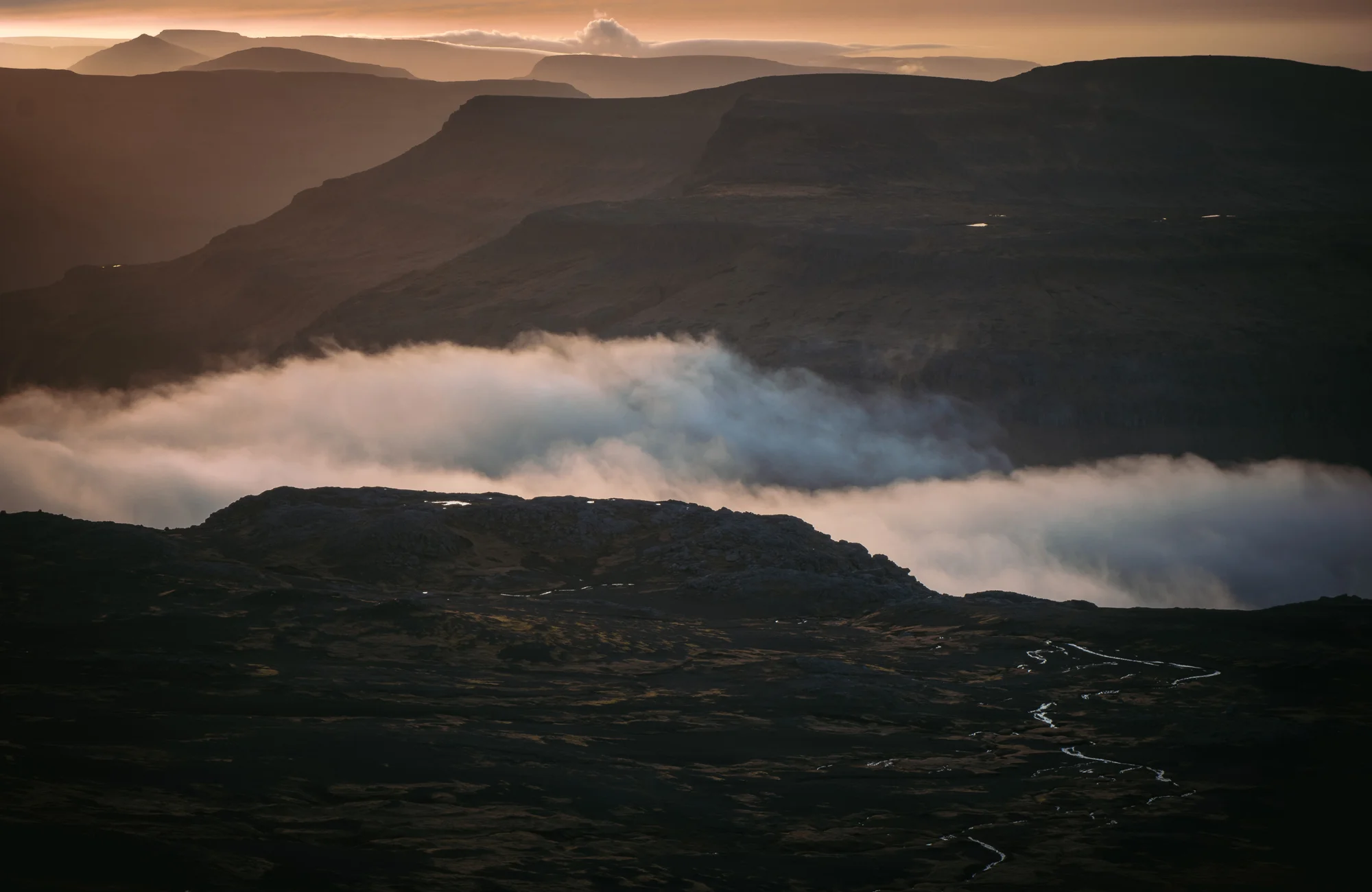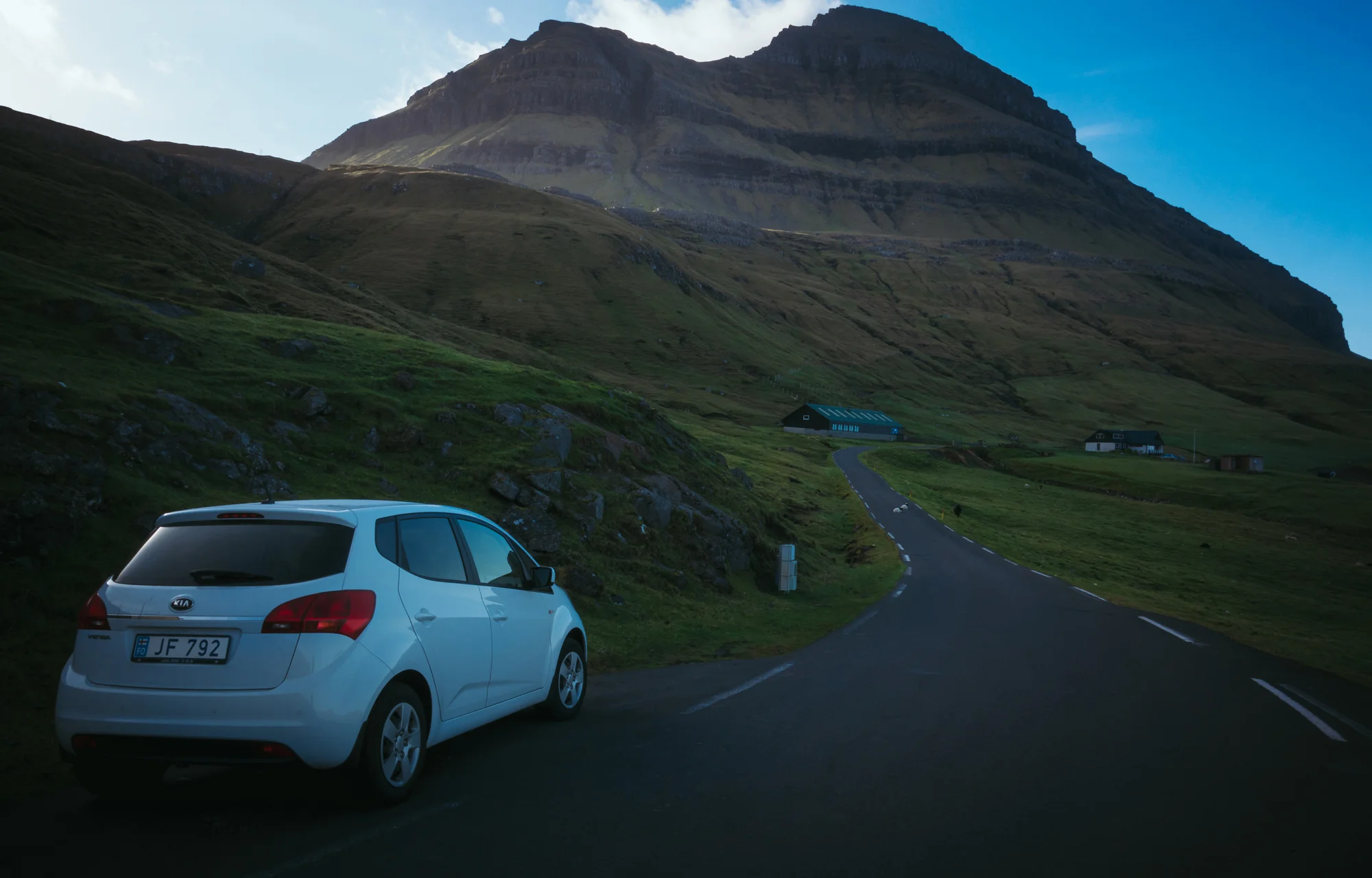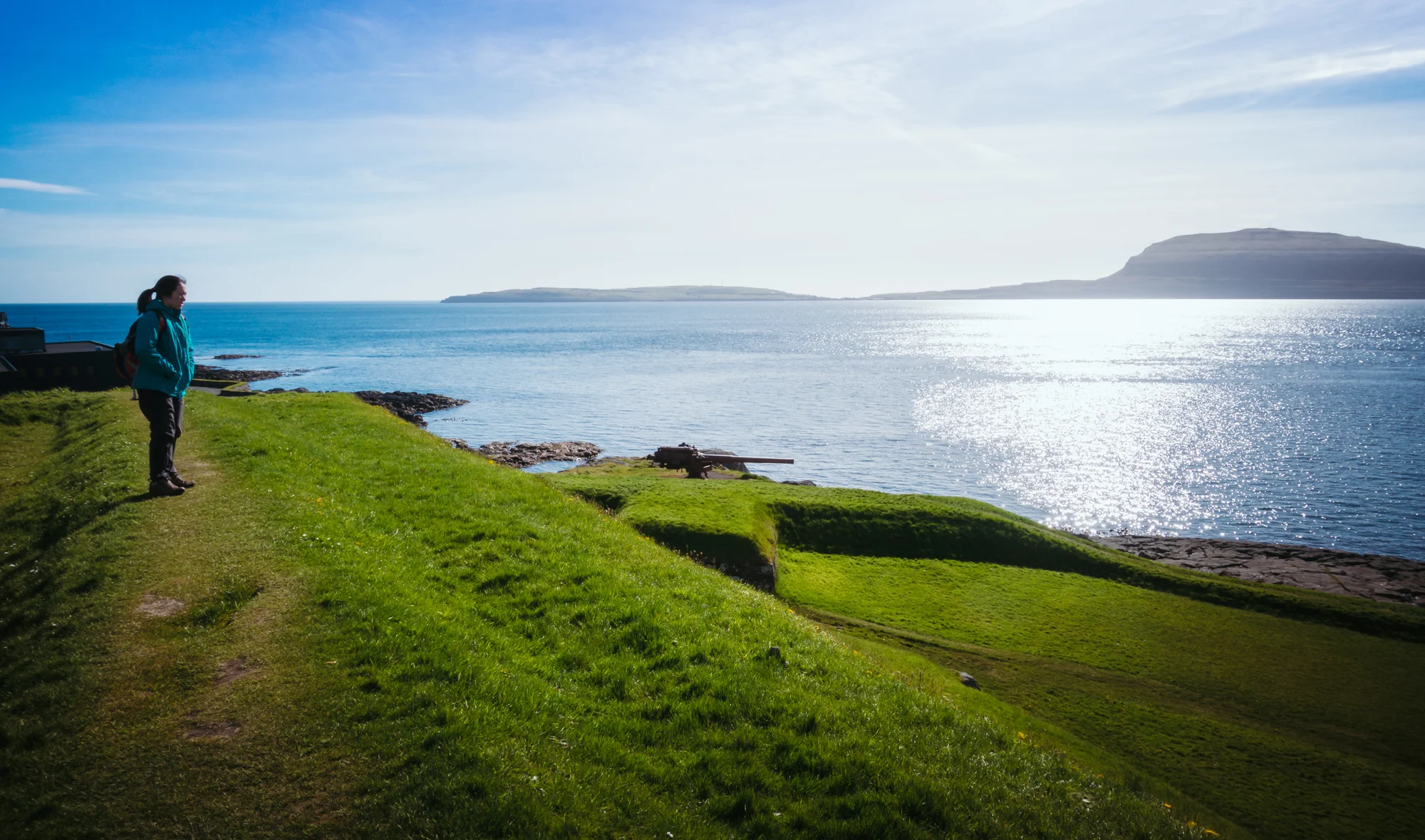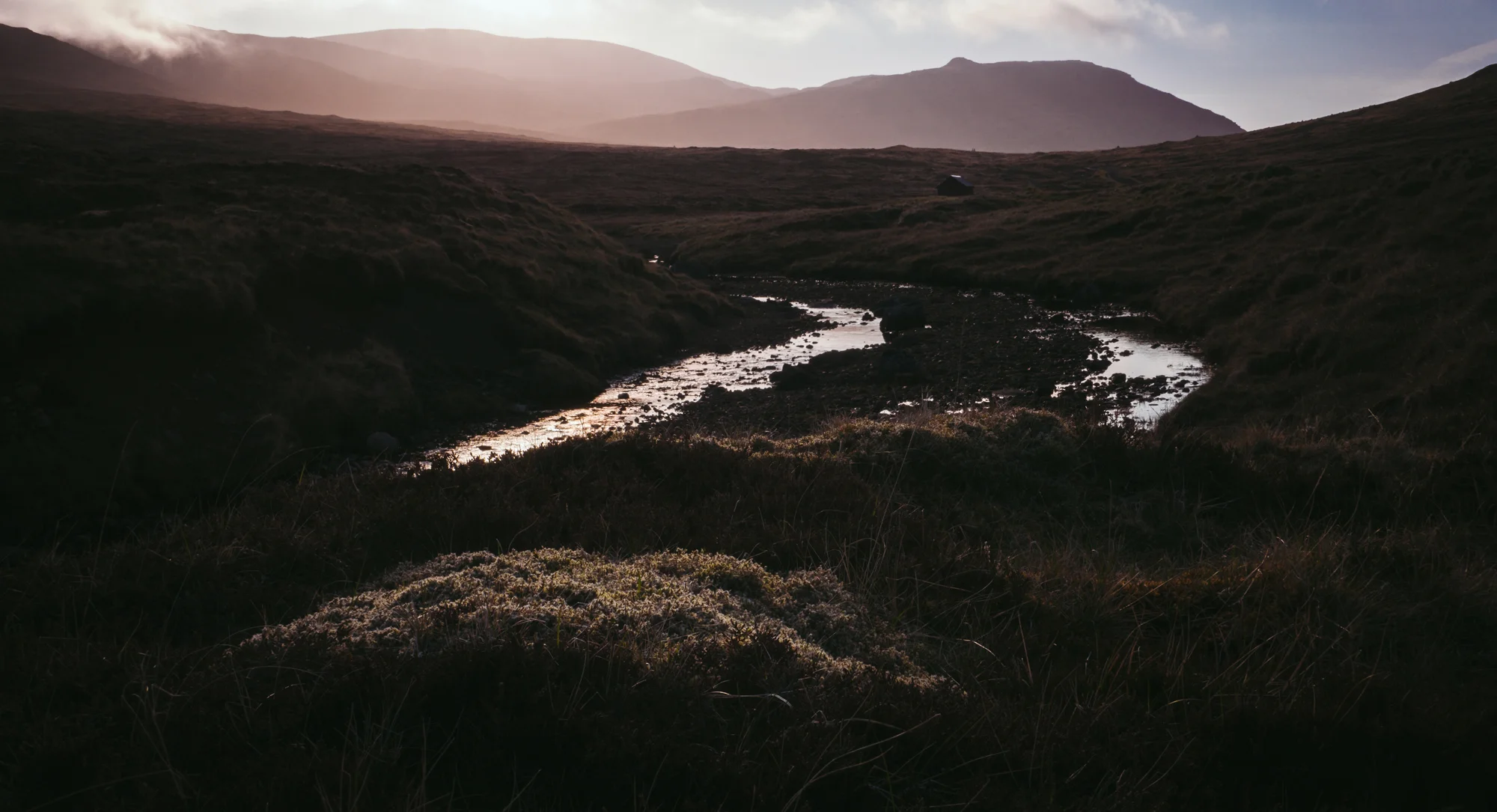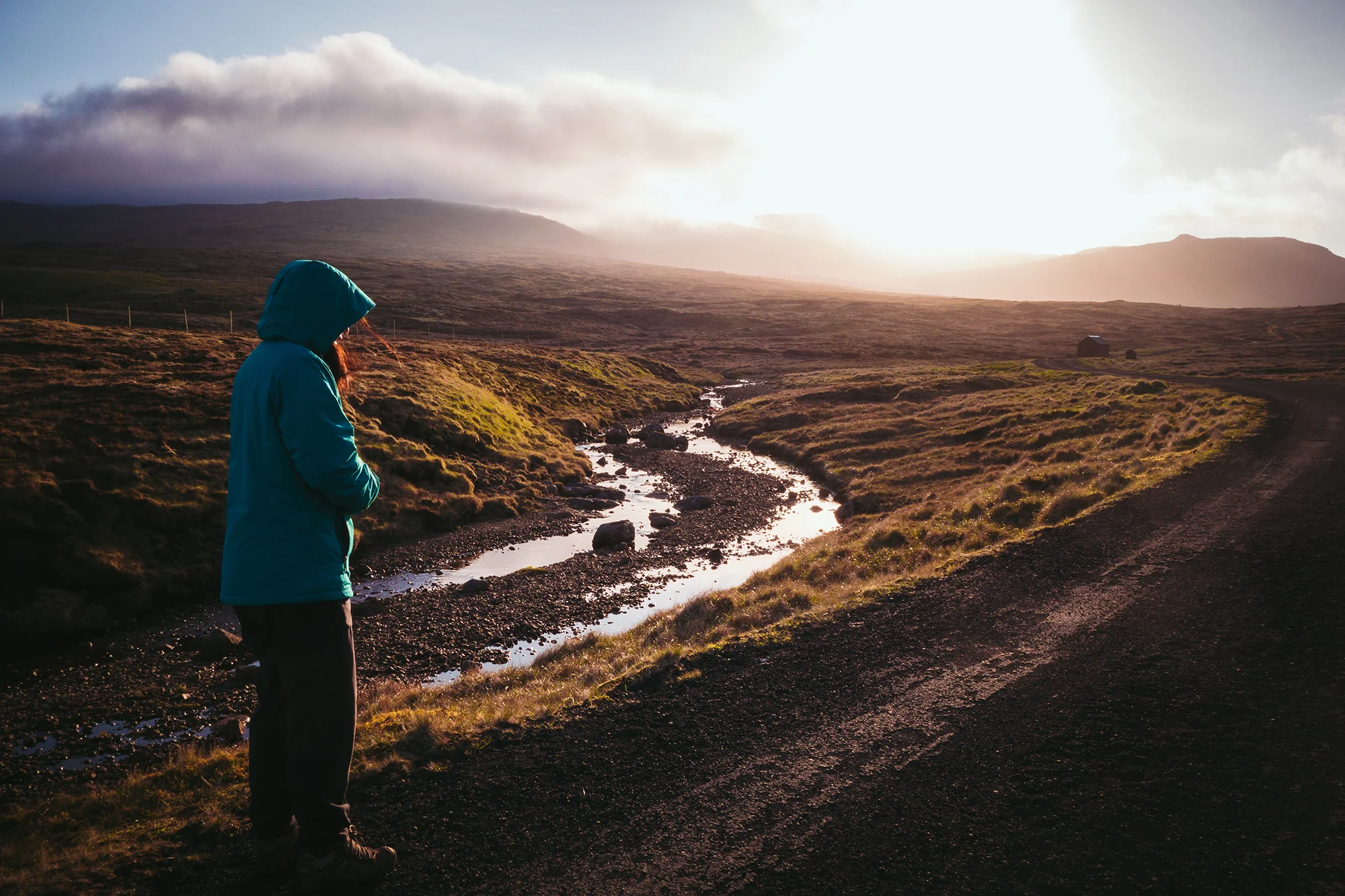The next morning is an early one. We’re up at 4 AM to catch sunrise on the neighboring island of Streymoy - the western half of the Faroes’ main island mass and home to its capital, Tórshavn. In the car, we leave Miðvágur heading east, climbing the mountain pass to the north of Sandavágur. From the pass, the road hairpins down the spine of the island before descending into an undersea tunnel (Vágatunnilin) beneath the sound. When we emerge a few minutes later, we find ourselves in a lush green river valley at the heart of Streymoy (“Island of Currents”). We follow the road for a few miles, passing a lake and another narrow tunnel before reaching a hilltop intersection. Here the road diverges into a southbound lariat that proceeds to the capital along either of the island’s coasts; we take the western road up into the mountains, and turn off onto an access road at the foot of the mountain Sornfelli.
We wind up the side of the mountain, ascending through wisps of marine fog blowing in off the twin fjords of Kollafjørður and Kaldbaksfjørður. High above the clouds, we reach Sornfelli’s mountain plateau - a broad and flat valley dotted with glacial erratics and interlaced by meltwater streams. Leaving the car at a small parking lot, we clamber up the steep, moss-covered hillside, to the crest of the mountain ridge.
Ahead of us, at the summit, is a defunct NATO radar station, now mostly used for meteorological purposes. Behind us, the neighboring summit of Skælingsfjall (“Skæling’s Peak”) rises imperiously out of the earth, its barren flanks proudly displaying the regular basaltic intrusion layers so characteristic of the taller Faroese mountains. To our right (west), the earth falls away precipitously toward the ocean. In the distance, we see our starting point in Vágar and the rock spire of Trøllkonufingur, from these heights a mere blip rising out of the water across the sound. To our left, the sun is rising in a slow northerly crescent, casting a soft golden light across the parallel mountain ridges of the Faroes’ eastern islands. We seat ourselves on a level patch of moss and savor the light show: I set the tripod for a timelapse of the cloud layers building off the fjord beyond the plateau and flowing past the mountains in the distance, while the second camera is used for panorama work and tighter compositions.
After nearly an hour at the mountaintop, we descend the hill and hop back in the car to retrace our route to Streymoy’s western coast on the other side of the mountains. We pass the village of Leynar and pull over by the side of the road just before we reach the little hamlet of Skælingur, which sits at the foot of the mountain that bears its namesake. These two villages are separated by a little stream called Breiðá, which flows through a ravine down the hillside and empties into the ocean. While Jane waits in the car, I climb up the hillside to take a few long exposure images of this little rivulet, the old stone footbridge that crosses it, and the sidelit mountain walls beyond. Afterward, we return to the highway and resume our course on the mountain road, continuing beyond the two east-facing fjords, past the island’s windmill array atop a rockstrewn plateau, and descending at last to Streymoy’s southeastern harbor and the capital city of Tórshavn (“Thor’s Harbor”).
It’s a sleepy, early Saturday morning - just past 8 AM - when we enter the capital. We drive down to the harbor and leave our car parked at a large public lot, which is all but deserted at this hour. The bars, cafés, stores, and even souvenir stands are closed, with most Faroese businesses adhering to limited weekend hours including a late Saturday opening time and Sunday closure in observance of the Sabbath. We wander aimlessly through the streets of Tórshavn’s city centre, admiring its beautiful, watercolor neighborhoods and its elegant houses which effortlessly marry sleek, modern Danish architecture with a touch of the timeless and traditional (sheepskin decor and turf roofs). After awhile, we locate what seems like the city’s only open business - a corner bakery and grocery store - and sit with pastries and coffee while we watch students wearing gym shorts, breakfast in hand, rush in and out of the neighboring fitness center.
While waiting for the city to awaken, we walk north along the waterfront, which with its colorful buildings and rows of sloops and yachts, calls to mind Copenhagen’s famous Nyhavn or, closer to home, Annapolis’ Ego Alley. On the outskirts of the city centre, we come to a tall grassy hill, atop which is perched Skansin (“The Jump”), a historic fortress built in the 16th century to defend the city’s port from privateers and raiders. We climb the hill for a commanding view of the harbor and the offshore island of Nólsoy, and spend some time admiring its stone fortifications, its diminutive lighthouse, and its naval cannons - rusty relics which were installed during the British occupation of the islands during the Second World War, to repel a German incursion across the North Sea that never materialized.
Returning to the historic part of town, we stop for brunch at a dockside coffee house (Kaffihúsið), where we order breakfast plates with grilled bacon and sausage, olive oil-dressed vegetables, fruit slices, Danish yogurt and granola, coffee and juice, and a single hard-boiled egg. After our meal, we stop at the local bookstore, where I am tempted by William Heinesen novels and woodcut naval charts before we settle on our typical trip fridge magnet - a simple square piece depicting of flock of the ubiquitous Eurasian oystercatcher (tjaldur), the Faroes’ national bird. We browse a few more stores (finding mostly tourist paraphenelia and pricey wool products) before returning to the car and making the hourlong journey back across the island, under the ocean, and to the front of Annika’s house in Vágar.
For our last evening in Vágar, we return to the lonely valley road that leads from the main highway toward Fjallavatn. Leaving the car by the side of the gravel road, I climb down the riverbank and set a timelapse of the sun fading behind the distant mountains, using the little stream as a leading line into the valley. The moorlands are rife with birdsong at dusk - the whirring of the oystercatchers, their bright orange beaks flashing through the sky as they move off the ocean, and the musical trill of a pair of whimbrel, dancing over our heads as they patrol around an unseen nesting site in the hills beyond the river. We watch the amber light of sunset fade from the valley walls before making the brief drive back to town, packing our bags for a new day of travel, and turning in for the night.






